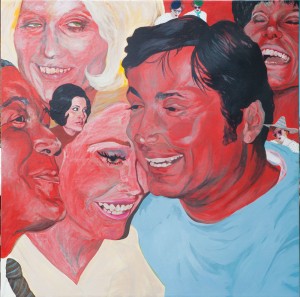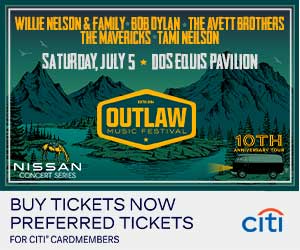NL: Those paintings influenced you?
DN: I see all of these works of yours, and you’ve done so much. Sometimes I’m doing things, and I look back and think, “Nancy already did that.”
NL: I can certainly look back and see that there is nothing new. You will be influenced by things, and you can never get away from that. You make it your own. What I really love is, I have a lot of young artists come up to me, and it happened last night. I had my picture taken with them. They were really young, and they told me that they had followed my work, and it’s really nice to have younger people come up and tell you that. That’s really a great feeling.

DN: Who have been your main influences?
NL: People that have influenced me? You name it. I can find something fabulous in just about anybody I can think of. When I started out, it was The Agony and the Ecstasy. That was the first book I ever read when I was 8 or 9 years old. My mother gave it to me because she really liked Irving Stone, and then they made that horrible movie about it. But early on it was Michelangelo, Caravaggio. Who influences me now? A lot of them are not painters. They are sculptors, like Anish Kapoor. Before he did “Cloud Gate,” he was doing these sinkhole things that were illusions, these big round holes in the floor that seemed to just sink down. I would really like to do a huge public sculpture someday.
I love the painters that when I look at them I think, “They are having so much more fun than I am.” You know that young artist Grant Gilliam? I have some of his paintings. I love how loose and wild his paintings were, and his subject matter is so great. I used to be in love with Janet Fish. I wrote her a fan letter when I was in high school. She never wrote me back. Andy Warhol, you know. I should have gone to New York with my friend Ricky, who always wanted me to move up there, but my mother didn’t want me to go, and I was a little scared to have to live with Ricky. He was good friends with Warhol, and I thought Warhol was a huge influence of my life. I would have loved to have met Warhol. Someone else I would have loved to meet during the time of the Fort Worth Circle was Blanche McVeigh. You should look her up.
And David Conn. David Conn was a huge influence on me. Jim Woodson was also a big influence. I loved those early paintings that he was doing in the 1970s.
DN: Were they the offset color paintings?
NL: I like those a whole lot too, the ones that had the brilliant blue like ultramarine, but it also had that purple in it. Whew! I loved those. I never got one of those either. Judye Wright Williams, Helen Silvestri, Shirley Grissom, Tom Grissom –– they were a huge influence on me.
DN: After I studied with Helen Silvestri in middle school, I saw her as an adult at the Will Rogers Flea Market and told her that she was the reason that I was still a representational painter and that it is so hard for me to break away from that. She told me, “No, that’s just because you can paint.”
NL: Something she said to me was, “Nancy, the way you paint a hand is what separates the men from the boys.” She didn’t have a feminist phrase for that, but, yes, I can draw. You can draw. If you can sit down and draw, it’s so helpful in so many ways. People ask, “Teach me how to paint,” and I say, “Well, you’ve got to learn how to draw first.” I always loved that about Helen because she understood what it was that I was doing, and she instilled a sense of confidence in me.
DN: I would like to talk about the future of art collecting in Fort Worth, particularly for young and emerging artists. Many younger artists, including myself, might assume that because of your success as a working artist that you have a lot of access to collectors and art supporters, and a lot of artists here don’t find their place within that system. I think Fort Worth loses some great young artists because of that. There are not enough galleries or local granting agencies that are really supportive of what artists do. How can patrons of Fort Worth support the major museums but lack a thriving collector base for local artists? I would think you would know better than anybody.
NL: When I was a young artist, there was more support from the museums here. There were more friendships and relationships with the artists. But this is the most important thing: Whoever is looking at me and thinking that I have the answers to their problems is never going to get from that problem to their own solution. The problem and the solution are on two different wavelengths. But there could always be more support.
DN: You can see how much the Dallas Museum of Art has stepped forward in that respect over the last couple of years. And the Nasher Sculpture Center is now giving micro grants directly to artists.
NL: Artists also have to work on their own relationships and social skills, and they can’t look to one person to change their lives. I’ve been doing this since I was 6 years old. I knew that I was going to be an artist since then. That’s 52 years of thinking about it. I live it every day. I dress it, I eat it, I study it. You have to immerse yourself in the things you want to do. I have a lot of friends and artists who are trying to figure out what their career is, and I think that everybody’s life is out there already. You just have to tune yourself in to what is your path in life.
DN: I asked you because what I am also curious about is this larger system. I see so much of the work that we artists do, the really hard work …
NL: It’s manual labor.
DN: Yes. There’s a system in place that the artists are the foundation of, but we don’t have access to the top of the pyramid.
NL: That’s not true. It’s not true that you don’t have access. But you have to figure out your way to get that access.
DN: Yeah, it takes a lifetime.
NL: What did I just say? I’ll tell you a story I bet you didn’t know. Jim Malone was in the Whitney Biennial. I didn’t know this about him, and I asked, “How the hell did you do that?” because I don’t feel like I have access to it either, and I should change my mind about that. But he was good friends with Henry Hopkins. Henry Hopkins loved artists. He was a painter himself, he loved being around artists, and he was the director of the Modern Art Museum of Fort Worth in the 1970s. When other curators came in, he would tell Jim to show up, and he would introduce them. All you need is to be introduced to somebody. And the minute you introduce someone, they start their own relationship. So that’s what happened for Jim, and they picked his work. That was such a huge deal in my eyes.
How do you think it happens? It’s because you know someone who knows someone who helps you out. The whole time I was growing up, people would go to New York or L.A., and they still do, and people will go somewhere else to buy work because they don’t think it’s good enough here.
DN: We need to show our work in other cities where we are no longer “local.”
NL: Do you think you would move?
DN: I always say, “Maybe in 10 years or so.” There will be a time when I won’t always have family here. There will be a time when I will have to support my own family, which may mean taking opportunities elsewhere.
NL: I used to tell people that I didn’t go to New York because of my family, and then when they died I didn’t go anywhere because I didn’t want to start over! But with the internet and social media, why can’t you just change the rules? People who make these unspoken rules make them to fit only their life, so why should I go by those rules? There are a million ways to live your life. You don’t necessarily have to move. It depends on how you want to do it, if you want to have a career like everybody else or live like the people you think are successful.
DN: True. What is one’s expectation? If you expect to lead a happy, peaceful life with friends and family, doing something that you love, you should be able to do that anywhere. And if you think that going somewhere else will lead to a different result, that is unrealistic, but it is a question I am often asked. Like, “Are you going to move to Dallas?” That is ridiculous!
NL: Dallas has some great places to live.
DN: Well, we can be there in 30 minutes.
NL: That is absolutely true. You can do anything you want. If you think about it, our lives are fabulous. And it keeps getting better.
Artist and educator Devon Nowlin is the gallery manager of TCU’s Fort Worth Contemporary Arts and is represented by Artspace 111.












This is a great interview. Thank you both for sharing.
Awesome.
Incredible interview. Incredible woman. Incredible art.